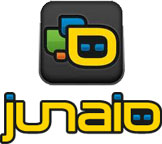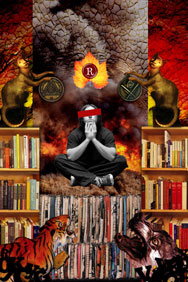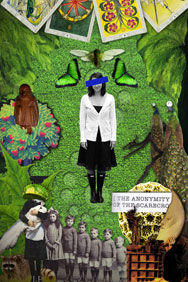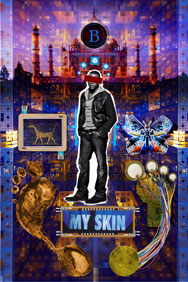

The Augmented Art
"A lot of what I do is squashing bugs. When you deal with complex systems, you get to a point where it takes a life of its own. That's why programmers are good at adapting. Compartmentalizing. But sometimes it doesn't matter what you do. Sometimes shit still happens."
Whispers is the story of three people: R, G, and B. Each character has a corresponding collage, composed of elements drawn from their lives and memories. Viewers use Android phones, iPhones or even iPads to interact with the posters via an augmented reality overlay of icons on these collage elements. When clicked, the icons trigger narrative fragments to appear on the wall, thus allowing viewers to piece together the emerging story of these lifelong friends by moving image to image.
The Art
When viewers first enter the exhibit they are confronted with three collages hung in a traditional manner upon the wall. The room is low-lit, so that the installed digital projector casts a clearly delineated light tailored to illuminate only the posters. This creates an overlay effect on the pieces that results in many viewers thinking they are not physical paper, but rather digital projections.
Each character has a collage, and a corresponding section of the narrative unlocked by it. The collages have a predominant color corresponding to each character's name: R, G, or B.

Augmenting Reality
The core of this section's functionality is built upon two technologies: Metaio's mobile augmented reality software Junaio, and a form of long-poll AJAX called comet.

Junaio was chosen as the vehicle for augmenting the collage artwork because of its many strengths for streamlining implementation. Junaio's app is already certified and accepted in the iTunes store as well as on the Android Market, which means that as soon as the content channel is ready, it is effectively live on both of these classes of devices. This is enormously more effective than trying to code an app from scratch, which would then require going through the red-tape of certification before it could be made available to users.
Junaio's other strength is that they segment out the form from the content. Their API is relatively straightforward, and also allows developers to use assets served from their own servers. This means that not only can content be updated and changed on-the-fly, but that there are no real practical limits on the depth or richness of the experience that can be coded through that medium.
The augmented reality content provided is a series of eye icons overlaid upon sections of the collages. The viewers then click on the icons, which causes them to disappear, and a post event to be sent to the server.
Long-poll AJAX is a poor man's node.js. The original intent was to implement using node.js, but it proved untenable to learn that technology on short notice. Instead, a comet approach is used such that when the server receives a post from a user from their device, it uses a database to choose the correct section of text, and pushes that out to display on a webpage. A laptop in the gallery is accessing the webpage while hooked up to a projector, such that the server can effectively push the text out onto the wall through the laptop.
The icons disappear once clicked, which helps shepherd the viewer through the text, but also prevents re-visitation. The intent is to create an experience where understanding is gained as more is revealed, but the new understanding can never be supported by re-visiting past texts, only through what is remembered of them.
"A lot of what I do is squashing bugs. When you deal with complex systems, you get to a point where it takes a life of its own. That's why programmers are good at adapting. Compartmentalizing. But sometimes it doesn't matter what you do. Sometimes shit still happens."
Whispers is the story of three people: R, G, and B. Each character has a corresponding collage, composed of elements drawn from their lives and memories. Viewers use Android phones, iPhones or even iPads to interact with the posters via an augmented reality overlay of icons on these collage elements. When clicked, the icons trigger narrative fragments to appear on the wall, thus allowing viewers to piece together the emerging story of these lifelong friends by moving image to image.
The Art
When viewers first enter the exhibit they are confronted with three collages hung in a traditional manner upon the wall. The room is low-lit, so that the installed digital projector casts a clearly delineated light tailored to illuminate only the posters. This creates an overlay effect on the pieces that results in many viewers thinking they are not physical paper, but rather digital projections.
Each character has a collage, and a corresponding section of the narrative unlocked by it. The collages have a predominant color corresponding to each character's name: R, G, or B.

Augmenting Reality
The core of this section's functionality is built upon two technologies: Metaio's mobile augmented reality software Junaio, and a form of long-poll AJAX called comet.

Junaio was chosen as the vehicle for augmenting the collage artwork because of its many strengths for streamlining implementation. Junaio's app is already certified and accepted in the iTunes store as well as on the Android Market, which means that as soon as the content channel is ready, it is effectively live on both of these classes of devices. This is enormously more effective than trying to code an app from scratch, which would then require going through the red-tape of certification before it could be made available to users.
Junaio's other strength is that they segment out the form from the content. Their API is relatively straightforward, and also allows developers to use assets served from their own servers. This means that not only can content be updated and changed on-the-fly, but that there are no real practical limits on the depth or richness of the experience that can be coded through that medium.
The augmented reality content provided is a series of eye icons overlaid upon sections of the collages. The viewers then click on the icons, which causes them to disappear, and a post event to be sent to the server.
Long-poll AJAX is a poor man's node.js. The original intent was to implement using node.js, but it proved untenable to learn that technology on short notice. Instead, a comet approach is used such that when the server receives a post from a user from their device, it uses a database to choose the correct section of text, and pushes that out to display on a webpage. A laptop in the gallery is accessing the webpage while hooked up to a projector, such that the server can effectively push the text out onto the wall through the laptop.
The icons disappear once clicked, which helps shepherd the viewer through the text, but also prevents re-visitation. The intent is to create an experience where understanding is gained as more is revealed, but the new understanding can never be supported by re-visiting past texts, only through what is remembered of them.



